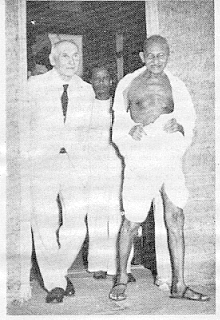| Early in 1946, the Labour Government despatched an all-party
parliamentary delegation to India to meet Indian leaders and convince them of the British
desire for an early settlement of the Indian constitutional issue. However, it was only in
March 1946 that with the arrival of three Cabinet Ministers, Lord Pethick-Lawrence, Sir
Stafford Cripps and Mr. A. V. Alexander, a crucial stage was reached in the negotiations
between the British Government and the Indian political parties. The negotiations were
conducted on behalf of the Congress by Abul Kalam Azad who was assisted by Nehru and
Patel. Gandhi was, however, frequently consulted. The negotiations were bogged down on the
basic question whether India was to remain united or to be split up to satisfy the Muslim
League’s demand for Pakistan. The Congress opposed to the partition of the country,
but was prepared to go to the farthest limit in conceding cultural, economic and regional
autonomy to various regions. A conference at Simla failed to resolve the Congress-League
differences. The Cabinet Mission then offered a compromise plan in their statement of May
16,1946. They sketched a three-tier constitutional structure for India. On the top was to
be a Union of India embracing British India as well as the Indian States, but dealing only
with foreign affairs, defence and communications. The bottom tier was to consist of
Provinces and States in which were to vest all residuary powers. The intermediate tier was
to comprise "groups" to be formed by Provinces (if they chose) to deal with
certain common subjects. The Muslim League avowed its acceptance of the Cabinet Mission
Plan, but this acceptance was more apparent than real, The League and its leaders made no
secret of their hope and design that the new constitution would be used to effect a
partition of the country. "Let me tell you," Jinnah told the Muslim League
Council on June 5, 1946 "that Muslim India will not rest content until we have
established full, complete and sovereign Pakistan." It was this apparent
contradiction in the League’s stand, which made Gandhi and his colleagues in the
Congress uneasy about the "grouping of provinces", which the League wanted to
make compulsory and a stepping-stone to Pakistan. The controversy on this issue wrecked
the Cabinet Mission Plan.
The three-tier constitution was a delicate mechanism with numerous checks and balances. Without the fullest cooperation between the major parties it was impossible to draft a new constitution, much less to work it. This cooperation was, however, lacking. The Cabinet Mission Plan was a compromise but it did not really bring the two parties together. The result was that questions presumed to have been settled by the Cabinet Mission were reopened soon after the return of its three members to England. Controversy rose to a fever pitch on two crucial issues, that of the "grouping"of provinces and the composition of the "interim government". |
